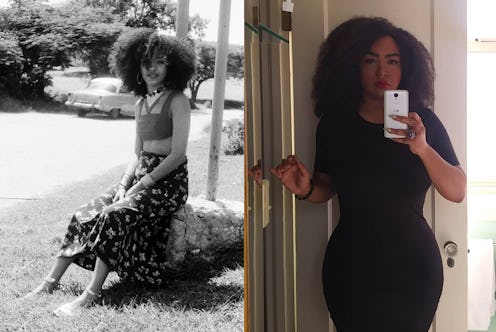Life
What 7 Afro-Latinx Women Wish You Knew About Their Identity
"We exist and we are a fierce, powerful, and beautiful people."

Not all Latinas look like Jennifer Lopez, Sofia Vergara, or Shakira. The damaging myth that Latinxs are a monolith is often fueled by both Spanish- and English-language media, resulting in erasure of blackness from Latinidad. In case it wasn’t clear, Latinx people are of all different races, co-occurring ethnicities, and identities. For these seven women who identify as Afro-Latinx, they’re all too familiar with these kinds of misconceptions.
A quarter of Latinx people in the United States identify as Afro-Latinx, according to a 2016 report from Pew Research Center. Across the world, Afro-Latinx people make up a notable percent of the population. About half the population of Brazil is of African descent, per Pew Research Center. 1.3 million in Mexico and close to 200,000 in Honduras identify as Afro-Latinx, according to the National Institute of Statistics and Geography and the CIA respectively. As Dr. Marta Moreno Vega, founder of the Caribbean Cultural Center African Diaspora Institute (CCCADI), put it, "There wouldn't be a United States if there wasn't African descendants present for the building of this country [...] but [also] the building of Latin America, the building of the Caribbean, and Europe.”
But rarely is it acknowledged that both identities can be celebrated at once. Cardi B, whose father is Dominican and mother is Trinidadian, is among the most prominent Afro-Latinx people in music and pop culture. In 2018, the popularity of Love & Hip Hop: Miami's Amara La Negra — an unapologetically Black, Dominican singer — on a major cable network introduced this cultural identity to a new audience. While many embraced her message, others, including castmates, began dissecting her identity, even accusing her of darkening her complexion, which she denied in an Instagram post. Ultimately, these attempts at invalidating her Afro-Latinx identity stemmed from a critical misunderstanding of what it means to be Afro-Latinx. Jenay Wright, creator of #IAMENOUGH, tells Bustle, "Afro-Latinxs comes in all shapes, body types, dialects, accents, customs, and skin tones."
As the conversation gains more visibility, these Afro-Latinx women are working to set the record straight about their identity. Here's what seven Afro-Latinx women want you to know about them.
1Afro-Latinx Doesn’t (Always) Mean Mixed
Juliana Pache, social media manager for The Fader and creator of #BlackLatinxHistory
“A lot of people think it means you have one Latinx parent and one African-American parent, which can be true for some, but is not how Afro-Latinx is defined,” says Juliana Pache, who identifies as Afro-Cuban/Dominican. “People often think we are mixed, and sometimes we are! For example, my father is a black Dominican, and my mother is a (mostly) white Cuban. Both are from Latin America. A lot of Afro-Latinxs have two black parents from Latin America, and I think that confuses a lot of folks.”
2Latinx Is Not A Race
Keyanna Gotay, founder of Brown Sugar and Canela and creator of student organization, Aguilas Afro-Latino
“Many fail to realize that Latino isn’t a race,” says Keyanna Gotay, who is Garifuna from Honduras. “Shocker, I know right? My race is black, while my ethnicity is Latina.”
3This Conversation Isn’t New
Mai-Elka Prado Gil, co-founder of the Afro-Latino Festival NYC
“There’s a misconception that this entire conversation is new,” says artist Mai-Elka Prado Gil, who is Afro-Panamanian. “This perception, unfortunately, exists even in our own community.”
“Our role is first to educate our own community about our history, and second to educate others,” she tells Bustle.
4We’re Unapologetically Black And Beautiful
Francis Carrero, communications professional
“I'm currently at a point in my life where I am unapologetically and blatantly Black,” says Francis Carrero, who is Afro-Dominican and a founding team member at Ain’t I Latina? “We exist and we are a fierce, powerful, and beautiful people. There are so many of us making an impact in our respective fields.”
5Acknowledging Afro-Latinx Identity Isn’t Divisive
Tamika Burgess, writer and creator of Es Mi Cultura
“I keep hearing that we are being divisive by referring to ourselves as Afro-Latinx,” Tamika Burgess, who is Afro-Panamanian, tells Bustle. “We are not trying to separate ourselves, we are simply celebrating our ancestry.”
6We Deserve Equal Opportunities
Zahira Kelly-Cabrera, artist, activist, and womanist
“What I want is for us to have equal access to resources and opportunities to thrive without having to wait on other nonblack Latinx's acceptance,” says Zahira Kelly-Cabrera, who is widely known as Bad Dominicana. “That's the barrier that remains."
7We Don’t All Look The Same
Jenay Wright, creator of #IAMENOUGH
“When I’ve been asked about what is an Afro-Latina and, I explain, I get confused faces. Because when you look at me, I have brown skin and extensions in and they have this image in their head that I am supposed to be light skin with curly soft hair,” says Jenay Wright, an Afro-Panamanian blogger. “They attach statements like ‘oh, so you’re mixed’ or ‘you’re exotic’ to the term Afro-Latinx. Afro-Latinxs comes in all shapes, body types, dialects, accents, customs and skin tones. There isn’t just one image of what an Afro-Latina looks like. Not saying there aren’t any Afro-Latinx with lighter skin and curly hair because there are. But there is also darker skinned Afro-Latinx with curly or kinky curl patterns, or some lighter skinned with even dreads or 4C hair texture.”
While the misconceptions highlighted by these Afro-Latinx women corroborate the fact that Latinx identity is still viewed through a singular lens, these women and countless other people are affirming their identity and educating along the way. Afro-Latinx women have and will continue to broaden the narrative.
This article was originally published on